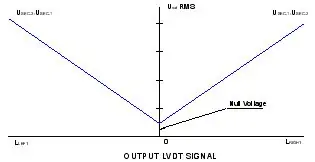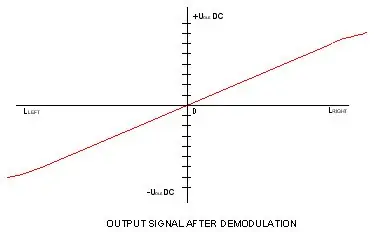An LVDT is basically a transformer. The primary coil needs to be excited, in order to induce a voltage in the secondary coils. The excitation needs to be an alternating voltage, in the 400 Hz to 20 KHz range usually. Square, trapezoid and other wave shapes can be used, but a sinusoidal shaped wave will yield the best results.
The voltage that is applied to the primary coil produces a current which its magnitude depends on the impedance of the primary coil at the chosen frequency. This current induces currents in the secondary coils of the LVDT.
The amount of current induced in each secondary coil depends on the mutual inductance between the primary coil and each secondary coil.
This mutual inductance, in turn, depends on the position of the core, with relation to each secondary coil.
The output of the LVDT is these two AC voltages, which can be added to one AC voltage. This voltage varies approximately linearly with the axial position of the core. A typical LVDT signal conditioning electronics will convert this AC voltage to DC voltage.

How LVDT Works
This figures illustrate the LVDT core at different positions with relation to the LVDT core position. The excitation energizes the primary winding, PRIM, at a constant amplitude AC voltage. The magnetic flux that is developed in the surrounding of the coil is coupled by the core to the two secondary coils, SEC.1 and SEC.2 . If the core is in the middle position, there will be equal flux coupled to each secondary. In this case the voltages, USEC.1 and USEC.2, induced in windings SEC.1 and SEC.2, will be equal. This middle core position is known as the null point.
When the core is moved to the right side in the drawing, more flux will be coupled to SEC.1 and less to SEC.2. In this case the induced voltage USEC.1 will increase, and the induced voltage USEC.2 will decrease. Alternatively. in the case that the core moves to the left side, more flux will be coupled to SEC.2 and less to SEC.1. The difference, USEC.1 minus USEC.2 changes with core position.

How LVDT Works
The graph shows how the amplitude of the differential output voltage, UOUT (equaling USEC.1 minus USEC.2), varies with core position. The slope of the curve depends upon the amplitude of the primary excitation voltage and the sensitivity factor of the particular LVDT. The sensitivity of typical LVDTs is in the rage of 10 to 100 mV/mm/V(excitation).

How LVDT Works